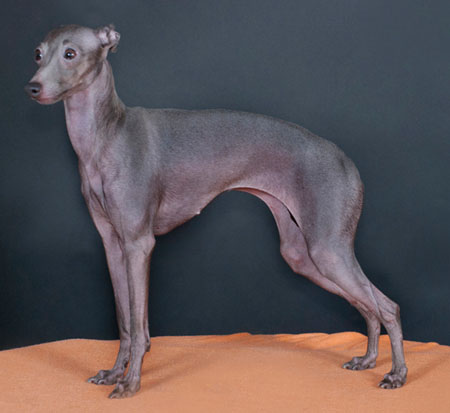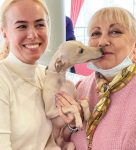13″ to 15″ at the shoulders is ideal for the show ring. The average weight is 8 to 12 pounds. Larger ones (17″ or 18″) are fairly common and make great pets.
HOW LONG DO THEY LIVE?
13 to 14 or 15 years is normal. 16 to 18 is not unusual.
ARE THERE MEDICAL PROBLEMS COMMON IN THE BREED?
Hypothyroidism and other autoimmune diseases, PRA, seizure disorders, luxating patellas, Legg-Perthes. None of them is rampant but all of these as well as some other genetic maladies have been diagnosed in some. A few bloodlines have a predisposition for leg fractures because of lack of bone density. At this time the IGCA is working with Dr. Acland of Cornell University to try to develop a blood test that would show up carriers of PRA. In the meantime, although no screening is required for any of the conditions named, the IGCA and other responsible breeders strongly recommend testing for PRA. Responsible breeders also have their dogs checked for Legg-Perthes, luxated patellas, heart irregularities and, if suspected, hypo-thyroidism. Some veterinary orthopedic specialists claim that bone density can be checked by x-rays, but there is some doubt as to the effectiveness of doing this. The IGCA’s health committee has been working on a study of patterns of heredity in excessive leg breaks but thus far there is no positive method of identifying the problem. Prospective owners of IGs should inquire of the breeder whether the sire and/or dam or any of their offspring have experienced fractures.
WHAT IS THEIR ENERGY LEVEL AND ATTENTION SPAN?
The energy level is quite high in healthy puppies and young dogs. Mature IGs are quite adaptive and responsive to the energy level of their owners. They are true sighthounds in miniature, and the attention span can be short if they’re bored.
AT WHAT AGE DO IGs MATURE?
Although IGs reach physical maturity between eight months and a year and a half, depending on their bloodline and their size (larger ones tend to keep growing for a longer period) most of them retain their puppy energy and playfulness well beyond that age. Some do not attain mental maturity until they are three or four years old –another characteristic which many fanciers consider to be part of the charm of this breed. Some other owners might be impatiently waiting for their dog to “grow up.”
WHAT ABOUT DOMINANCE AND SUBMISSIVENESS?
A single IG is usually submissive in nature; but in a situation that involves several IGs or other breeds of similar or smaller size there can be fights for dominance in the pack. A caveat here is that many fanciers new to this lovable and affectionate breed refuse to believe that these normally sweet dogs may be small, but they are true hounds and they have a strong tendency toward pack behavior. More owners than I care to mention have come home to find that an ill, old or otherwise weak “pack member” has been severely attacked by the stronger dogs.
TRACTABILITY AND TRAINABILITY?
Again, these are sighthounds and individuals vary greatly in these characteristics. If they were human they would do better in a liberal arts school than at a military academy. Some do superbly in obedience competition, and others don’t do well at all. Much depends on the trainer’s ability to keep the IG interested. Agility is a sport that could have been invented for the IG, and they make excellent therapy dogs. Some are even adept at lure coursing, although the latter should be undertaken with a degree of caution.
ARE THEY HARD TO HOUSEBREAK?
Most owners say they are, and some IGs can be stubborn about it. It’s especially hard to persuade an IG to ask to go out in extreme weather. IGs are lovers of warmth and really despise going outside when the weather is cold, wet or windy. They also often don’t ask to go out. A routine and schedule along with a crate when not home are the best tools for training. Many have success with paper or litterbox type training especially in cold and/or wet climates.
ARE THEY PROTECTIVE?
Most IGs will bark an alert warning when someone or something strange approaches. They aren’t likely to do more than bark and behave in an agitated manner in the face of danger to their owner or property, although there are exceptions to this too.
CAN THEY LIVE OUTDOORS?
The IG is definitely an “inside dog.” Outdoor play and walks on warm days are enjoyed, but this isn’t a dog that can be left alone to fend for itself in the back yard.
WHAT ABOUT GROOMING?
This is minimal, but teeth and toenails need regular attention. The coat is so short and fine that a bath is rarely necessary. Teeth can be bad and need regular brushing.
DO THEY SHED?
Yes, but the hair is so short and fine that it can hardly be seen.
ARE THEY LOW MAINTENANCE PETS?
The amount of time not used for bathing and grooming is required tenfold for attention and love. IGs can be almost needy in their desire for affection.
ARE THEY GOOD WITH CHILDREN AND OTHER PETS?
IGs have great rapport with gentle children who understand that this is a living creature and not a toy that can be manhandled. An IG could be injured by a thoughtless child. The same is true of interaction with other animals. Due to their fine bone structure and risk of leg breaks, they are not recommended for young children. They get along well with cats and other dogs of similar size but must be protected from rambunctious larger pets.
DO THEY NEED ANY SPECIAL CARE?
A sweater or jacket is in order in cold weather. Although the IG is not as delicate as he looks, care must be taken to avoid “booby traps” that might result in a broken leg. Not likely to run away simply to explore, many IGs would run into the street or even take an incredible leap from a balcony or open window in playful pursuit of a cat or other animal —or to follow their masters. This breed should NEVER be walked off lead, since another dog or something unusual might spook them, causing them to bolt.
WHO SHOULD NOT OWN AN IG?
People who have too little time to devote, who have unruly children, who expect instant and unerring obedience, who expect their dog to stay in the back yard, or who are embarrassed to share love with an animal should not own this breed.
ARE THERE ANY BAD THINGS ABOUT IGS?
They require and demand lots of love and attention. Denied this, they can become shy or hyper or both. They must be properly socialized as puppies. Those that are kennel raised under impersonal conditions can have difficulty adjusting. If expected to spend much time outdoors they are not suitable for cold climates. IGs are very athletic, and their jumping and climbing abilities can get them into trouble. Babygating does not work as they can jump so high. They also have no traffic sense, and an IG that gets into the street is almost destined to be hit. Since they are hounds, they can be quite stubborn.
SHOULD THEY BE CRATE TRAINED?
Certainly, but please don’t confuse crate training with house training. All dogs should learn to stay in a crate quietly for short periods of time, up to three or four hours; but a crate should not be used to confine an IG all day long every day while its owner is at work or play. Dogs are not intended to be caged animals like laboratory rats.
WHAT ABOUT THE HISTORY OF THE BREED?
The IG goes back a long way in history as does the large Greyhound, probably originating as long as 2,000 years ago in the areas that are now the countries of Greece and Turkey. A small sighthound is depicted in the early art works of these nations, and bones indicating a dog of this type have been found in archeological sites.
The breed became popular in Southern Europe during the Middle Ages and by the 16th Century many were depicted in Italian paintings and sculpture. It is for this reason, not because of its origin, that the little hound became known as the Italian Greyhound. Its larger cousin, the Whippet, originating in England in the 19th Century, is a relatively new breed that started as a mixture of large Greyhound and terrier and later incorporated some Italian Greyhound blood to add refinement.
The IG has always been a favorite of royalty and aristocracy, and many paintings show historical figures such as Princess Anne of Denmark, Queen Victoria and Catherine the Great of Russia with their beloved IGs. It is a well known fact that Frederick the Great was a great fan of this breed and was almost always seen with one or more of them.
There is some question whether the IG was originally intended to hunt small game or vermin or mainly to be a beloved companion. Most likely both of these theories are true. Many IGs have a strong instinct to hunt and chase. Others have none, since, at least during the past century or so, they have not been bred for this characteristic. It is also likely that they became a popular household pet during the days before central heating, because their warm little bodies can be very comforting in an otherwise cold bed.
The first IG was registered by the American Kennel Club in 1886, but the breed remained quite rare in the United States until fairly recently.
Article was taken from http://www.k9web.com/dog-faqs/breeds/italgreys.html




